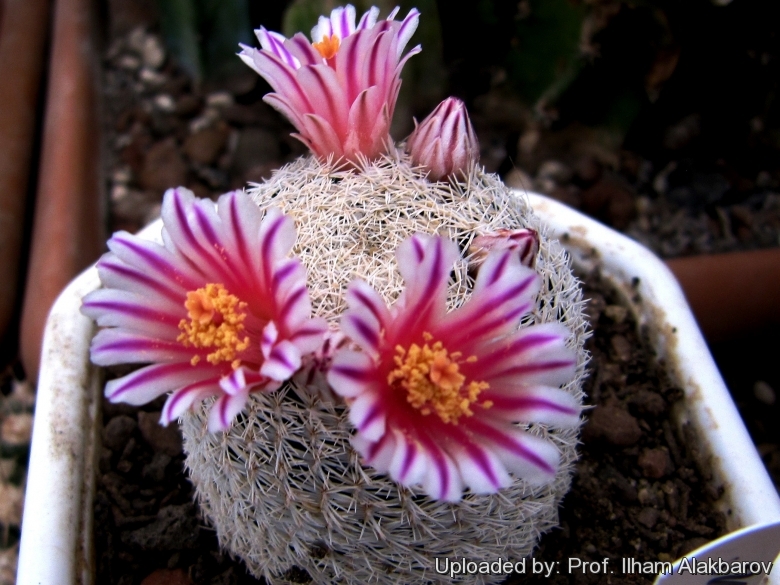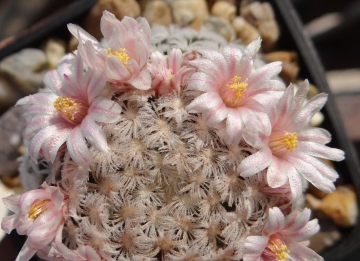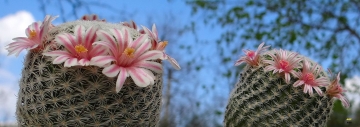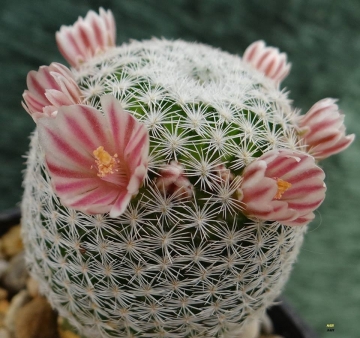
Mammillaria hermosana Photo by: Prof. Ilham Alakbarov
Origin and Habitat: Zacatecas (Mexico, Northern America). The species is rare and uncommon, with two known disjunct populations, with relatively small numbers of plants in each.
Type locality: Municipio Villa de Cos.
Synonyms:
Description: Mammillaria hermosanaSN|14981]]SN|32495]], formerly known as Mammillaria schrottiiSN|10779]]SN|32496]] n.n., is a tiny Mammillaria species belonging to the Mammillaria lasiacanthaSN|9075]]SN|9075]] group.
Distinguishing characteristics: This is a very distinctive little species with small round shaped stems, thick fleshy roots and dense, pectinate spination which serve to protect it from the harsh sun common to its native habitat. More precisely the spines benefit the plant by reducing sun exposure and by trapping a layer of air next to the cactus body. This helps to cool the plant in the summer and keep it warm in the winter. The outstanding, bright coloured blooms are followed by fruit partially embedded in the pant body.
Derivation of specific name: The name 'hermosana' is derived both from the nearby village of Vista Hermosa, located along the Zacarecas - Saltillo road, and simultaneously in the double meaning of the Spanish word 'hermosa' = pretty.
Stem: Single, flatten globular, to 35 mm across, 2-10 mm tall, becoming round to ovoid in culture.
Root: Thick taproots, fleshy, large in upper portion.
Tubercles: Cylindrical, 5-6 mm long, 2 mm in diameter, green.
Areoles: Oblong, 1-2 mm long. Axils bare.
Radial spines: 22-30, acicular-bristly, white to off-white, 1.5-2.5 mm long, pectinate, flattened against the stem surface or somewhat spreading in several planes and interlacing.
Central spines: Usually absent, rarely a single, rudimentary, slightly protruding central spine is recognizable from the horizontal radial spines.
Flowers: Broadly funnel-shaped, 18 mm long, up to 23 mm in diameter. Outer perianth segments spatulate, dirty white to yellowish, with brown to reddish-brown center stripe. Inner perianth segments about 14, broadly lanceolate, white with broad strong purple median strip. Filaments whitish-pink.Anthers light yellow. Stigma lobes 5-6, olive green, about 1.5-2 mm long.
Fruit: In two forms: round to round-oval, parchment-like translucent, with slightly withered flowers remaining, 3-5 mm in diameter, 3-5 mm long, not protruding beyond the tubercles; or clavate, red, 15-20 mm long, up to 8 mm in diameter. Both fruit forms deeply embedded in the body for about 3 mm.
Seeds: Roundish, 1.1 mm long, 0.8 mm wide and 0.8 mm thick, dull black.
Taxonomy note: The authors of the new description, Linzen, ten Hoeve et Martínez-Ávalos, have placed this species in the Series Herrerae, along with Mammillaria sanchez-mejoradaeSN|32496]]SN|10779]] and Mammillaria roemeriSN|32495]]SN|14981]].
Bibliography: Major references and further lectures
1) “Mammillaria hermosana” Mammillaria of the Month, motm-2014-09 Retrieved 02 February 2016 <http://www.mammillaria.net/index.php/mamm-info/14-mamm-of-the-month>
2) Linzen , Hoeve & Mart.-Aval. “Mammillaria hermosana spec. nov. - ein neues Mitglied der Reihe Herrerae Lüthy (Mammillaria hermosana spec. nov. - a new member of series Herrerae Lüthy)” Original description in: Mitteilungsblatt des Arbeitskreises für Mammillarienfreunde 38(1): 4, photogrs. 2014
 Mammillaria hermosana Photo by: Agócs György
Mammillaria hermosana Photo by: Agócs György Mammillaria hermosana Photo by: Agócs György
Mammillaria hermosana Photo by: Agócs György Mammillaria hermosana Photo by: Agócs György
Mammillaria hermosana Photo by: Agócs GyörgySend a photo of this plant.The gallery now contains thousands of pictures, however it is possible to do even more. We are, of course, seeking photos of species not yet shown in the gallery but not only that, we are also looking for better pictures than those already present.
Read More... Cultivation and Propagation: Mammillaria perezdelarosaeSN|11894]]SN|11894]] subs. andersoniana is a great looking cactus with showy white and purple flowers, but is very sensitive overwatering.
Soil: Plants should be allowed to become crowded in their pot. Keep in shallow pot.
Soils: It likes very porous standard neutral cactus mix soil.
Repotting: Use pot with good drainage. Plants should be allowed to become crowded in their pot. Keep in shallow pot.
Fertilization: Feed with a high potassium fertilizer in summer.
Water requirements: It needs regular water but do not water again until dry, as it is specially sensitive to over watering. Also, it is a species that is dormant in the winter and require very little water (maybe even none) during the cold months.
Frost Tolerance: Light frost protection required. Minimum of 5ºC for safe growing (but hardy up to -5°C or less.)
Sun Exposure: High levels of light are needed to flower and for good spine development. Can be sunburned if moved from shade/greenhouse into full sun too quickly. During the spring it may be able to take full sun until the heat arrives at the end of spring. In an area that has hot afternoon sun, it may be able to take full morning sun, but requires afternoon shade or afternoon light shade.
Propagation: Seeds. Seeds germinate in 7-14 days at 21-27° C in spring, remove the glass cover gradually as the plants develops and keep ventilated, no full sun for young plants!













